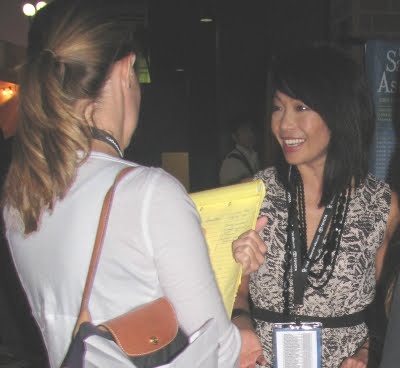
When this movie came out (1973) I was three-years old. I'm not sure if my immigrant parents ever watched it, but now, 37 years after the fact (that sounds so scary), I finally watched the cheesy, fun-filled ENTER THE DRAGON. It's a film I feel like I've seen given all the parodies, copycat plots, and Bruce Lee mania... not to mention the quotes still live on ("You have offended my family, and you have offended the Shaolin Temple").
While I don't think this film was meant to be as funny as it was, I was rolling with laughter from the pit of my stomach, and at times, cringing at the hysterical stereotypes in this film. From Roper (John Saxon) the gambling white guy and his pathetic opening fight scene at a golf course, to the Black Panther afro-sporting karate man, to the sinister Mr. Han and his iron hand. (And what was up with that random Chinese Hitler lookin' dude who was gambling during the tournament?) Oh, and don't get me started with the circus atmosphere at the "welcome party" on the island with acrobats, exotic Chinese food, women, and the sumo wrestlers (hellloooo, that's a JAPANESE sport, wth?)
My husband swears that when he first watched this film (when he was 12), it coolest movie he had ever seen, even though it opened the doors to every ignorant kid asking him if he knew kung fu while growing up. But for someone like me who didn't grow up watching 70 s martial arts films, the sophistication of today's CGI-filled stunts and action films, really makes ENTER THE DRAGON that much more laughable. I couldn't help but notice how bad all the extras were while practicing their punches, and especially the lack of finesse (and flexibility) by Saxon, who in the end, kills the burley Bolo (yeah right, but I relented and went with it)
s martial arts films, the sophistication of today's CGI-filled stunts and action films, really makes ENTER THE DRAGON that much more laughable. I couldn't help but notice how bad all the extras were while practicing their punches, and especially the lack of finesse (and flexibility) by Saxon, who in the end, kills the burley Bolo (yeah right, but I relented and went with it)
Of course, what saves this film is Bruce Lee, the Legend alone. First of all, that man has the art of the "sneak" down pat! The way he slithers around, darts his eyes, and then quickly moves his head to the side is so classic. Secondly, the man's body has 0% body fat, and he's ripped (by 1970s standards). It's obvious he's the one and only true martial artist in this film. And most importantly, his commitment and intensity is so impressive.
The predictability of this film made it even more entertaining. Although I do feel like it lacked completion because we never learned what happened to Bruce's girl on the island. Oh, and I was quite shocked that the films credit roll took about 30 seconds. Things have really changed in the last 40 years!
